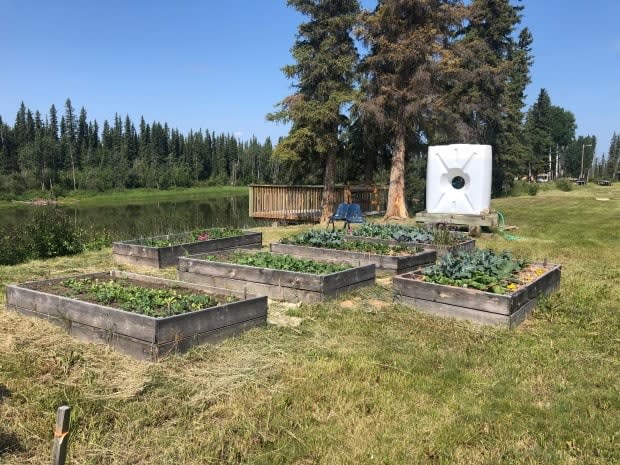From ashes to greenhouses: How this N.W.T. community is getting closer to sustainable food

How does a community look into its own local food economy — that is to say, the way it produces and manages sustainable food?
The hamlet of Kakisa, N.W.T., a small community off the Mackenzie Highway, is in a good position to try to find out. That's partly because it has a small population — about 36 people, according to a 2016 census.
People there have been working with researchers at Wilfrid Laurier University on a number of projects to create food security, from building greenhouses to making compost.
And, as another step toward their goal, they are now hiring someone to oversee the project.
A new way to harvest
When a forest fire nearly wiped out the land around Kakisa back in 2014, including damaging trails that used to help serve as hunting grounds, Lloyd Chicot, chief of Kakisa, says elders recommended the community look at how food is gathered in a new way.
"With the climate change, everything's changing," Chicot said.


"One of the things that [elders] had wanted us to do was to start looking at our food, what we have in the community now, and how … most of our members are getting their food off the land."
He said about half of it comes from harvesting while the other half comes from stores. But he said some wild resources have gone untapped for some time.
"Some of the elders have talked about getting lots of berries, fish, moose meat, wild potatoes, wild onions and that kind of stuff," Chicot said.
"So we had wanted to do a little more research to see how we could start looking up some of these things that are out there but really haven't been taken advantage of."
Getting the most out the projects
Andrew Spring, an adjunct professor and research associate in northern knowledge networks at Wilfrid Laurier University, says the first food growing projects in the hamlet started with installing raised garden beds.
"Then last year, we actually put in two greenhouses," he said.

"We're thinking about a bunch of different kind of neat little projects. But we want to figure out how to run them and how to manage them, and how to get the most out of these projects."
That's when an opportunity came up to hire someone to look at the economies of food in the North, and not just the financial or economic impact of these projects. Spring said it's also to look at how these food projects can increase health, social and cultural connections in these communities.
"So this opportunity came up, we jumped on it. It's a really good opportunity to get Noda Enterprises engaged [Kakisa's economic development arm] and get that organization kind of back up on its feet," he said.

Value in relationships
Chicot said one of the goals was to encourage a two-way working relationship.
"So that … some of our students are learning, and us at the same time are teaching some of the other students to go out there to gain this knowledge ... to further their career," he said.
Spring said the basis of all this work has been developing this relationship.
"I think there's so much knowledge and innovation happening in communities," Spring said.
"It's just wonderful to work with the community, like Kakisa, who have been so welcoming and willing to try all sorts of projects."

 Yahoo Movies
Yahoo Movies 